HR+, HER2- Early Breast Cancer
HR+, HER2- Early Breast Cancer: High-Risk Features and Recurrence Risk
Incidence of hormone receptor–positive (HR+), HER2-negative (HER2-) breast cancer
Most patients with early breast cancer (EBC) have HR+, HER2- disease. Breast cancer molecular subtypes at diagnosis includes1:

Breast cancer molecular subtypes at diagnosis
- 72.7% is HR+, HER2-
- 12.2% is TNBC
- 10.3% is HR+, HER+
- 4.6% is HR-, HER2+
EBC has no spread detected beyond the breasts and lymph nodes in and around the breasts and has gone only as far as the lymph nodes in the armpit(s).2 Some patients with EBC have cancer cells that are more aggressive and more likely to grow and spread quickly, which means there is a higher risk of the cancer recurring.3,4

Recurrence rates
~30% of patients with high-risk, HR+, HER2- EBC may experience recurrence within 5 years, often with distant metastases.5
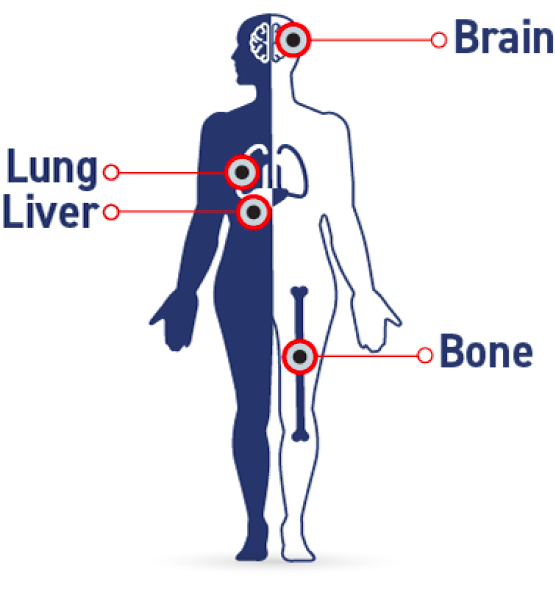
Sites of recurrence
Most disease recurrence occurs at distant sites.
Common sites of distant recurrence include the bone, liver, lungs, and brain. Although local and regional recurrences are treated with curative intent, distant recurrences remain largely incurable but are treatable.6,7
Common sites of distant recurrence:
Some clinical features of high-risk disease
Patients with HR+, HER2- breast cancer at high risk of recurrence may present with 1-3 positive ALNs with grade 3 disease or tumor size ≥5 cm, or ≥4 positive ALNs.5 As healthcare providers, it is important to recognize the features associated with a higher risk of recurrence.
Factors associated with a high risk of early breast cancer recurrence include 1 to 3 positive ALNs with grade 3 disease or tumor size greater than or equal to 5 cm or greater than or equal to 4 positive ALNs.
EBC: clinical and pathological factors associated with a higher risk of recurrence8-10
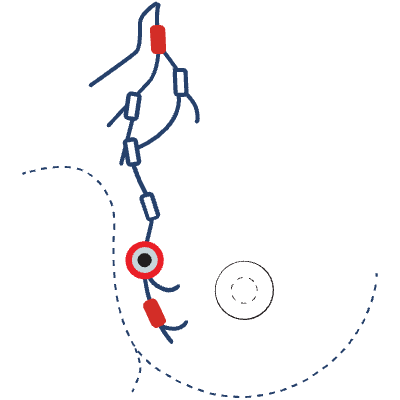
Stage 3
Patients with stage 3 disease have a 2.0x increased risk of recurrence over 10 years vs patients with stage 1 disease

Grade 3 disease
Patients with grade 3 disease have a 3.9x increased risk of distant recurrence over 10 years vs patients with grade 1 disease

Tumor size ≥5 cm
Patients with tumor size greater than or equal to 5 cm have a 1.5x increased risk of distant recurrence over 10 years vs those with tumor size less than 5 cm in node-positive patients
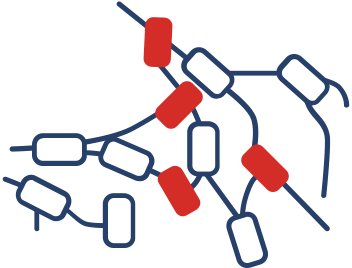
≥4 Positive lymph nodes
Patients with greater than or equal to 4 positive lymph nodes have a 3.0x increased risk of recurrence over 5 years vs those with negative lymph nodes
Recurrence risk peaks at 2 years after primary diagnosis
Regardless of disease stage (stage 1, 2, or 3) or nodal status (≥4 ALNs or 1-3 ALNs), a peak in early recurrence was observed in all patients at 2 years after primary diagnosis.8,12
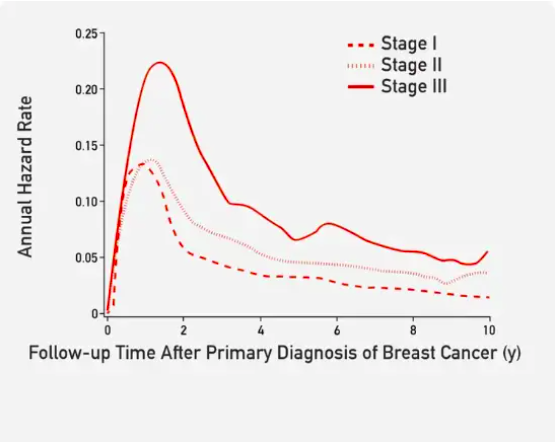
Risk of Recurrence by Stage in Patients With HR+ EBC8
For patients with stage 1, 2, or 3 breast cancer, the curves for annual hazard rates were similar, with a steep incline at 1-2 years of follow-up.
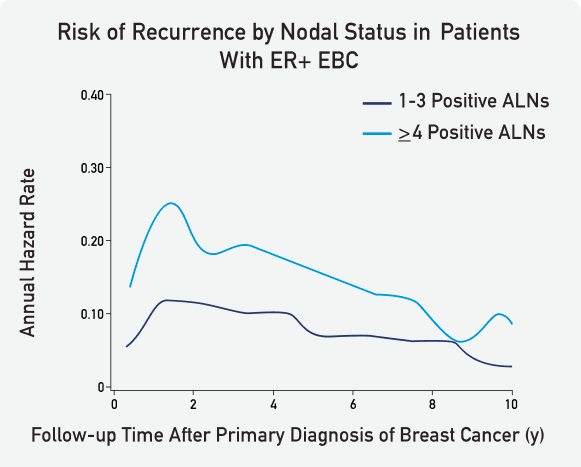
Risk of Recurrence by Nodal Status in Patients With ER+ EBC12
`
For patients with ER+ (estrogen receptor-positive) early breast cancer, the annual hazard rates inclined and peaked between the 1- to 2-year mark for all patients with nodal involvement (≥4 ALNs and 1-3 ALNs).
ER levels of 10 fmol/mg or greater of cytosol protein based on chemical assay were classified as positive.

Quantifying risk of recurrence with patients
As healthcare providers, it is important to help our patients with breast cancer have a quantitative understanding of their risk of recurrence over the course of their treatment journey.
Knowledge on disease prognosis may help patients adjust expectations, boost treatment adherence, and increase involvement in shared decision-making.13
Related Resources
Downloadable PDFs
INFOGRAPHIC: High-risk HR+, HER2- EBC Prognosis and Risk of Recurrence (PDF)
Clinicopathologic features of early vs late recurrence of HR+, HER2- EBC
Dr. O’Shaughnessy elaborates on the spectrum of high-risk HR+, HER2- early breast cancer and discusses the clinicopathologic features associated with early and late recurrence.
Understanding the risk of recurrence of HR+, HER2- EBC
Dr. O’Shaughnessy shares how she communicates risk of recurrence to her patients with HR+, HER2- early breast cancer patients who may be at high risk.
Communicating the quantitative risk for recurrence of HR+, HER2- early breast cancer
Dr. O’Shaughnessy elaborates on her approach on setting expectations and quantifying risk of recurrence for patients with HR+, HER2-, early breast cancer at a high risk for recurrence.
References
- Howlader N, et al. J Natl Cancer Inst. 2014;106(5):dju055.
- https://www.cancer.gov/publications/dictionaries/cancer-terms/def/early-stage-breast-cancer. (Accessed January 29, 2024).
- https://www.cancer.gov/publications/dictionaries/cancer-terms/def/recurrent-cancer. (Accessed January 29, 2024).
- https://www.cancer.gov/publications/dictionaries/cancer-terms/def/aggressive. (Accessed January 29, 2024).
- Sheffield KM, et al. Future Oncol. 2022;18(21):2667-2682.
- Gerber B, et al. Dtsch Arztebl Int. 2010;107(6):85-89.
- Cardoso F, et al. Ann Oncol. 2020;31(12):1623-1649.
- Cheng L, et al. Cancer Epidemiol Biomarkers Prev. 2012;21(5):800-809.
- Holleczek B, et al. BMC Cancer. 2019;19(1):520.
- Pan H, et al. N Engl J Med. 2017;377(19):1836-1846.
- Brown J, et. al. Poster presented at: SABCS 2019. Poster P5-08-18.
- Colleoni M, et al. J Clin Oncol. 2016;34(9):927-935.
- Ciria-Suarez L, et al. Front Psychol. 2020;11:540083.
VV-MED-154879